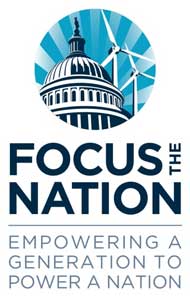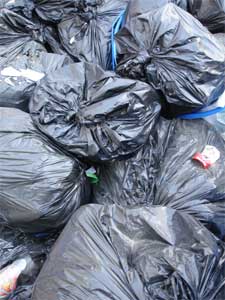 Recently the United Nations Environment Program added nine new chemicals to it’s original “dirty dozen” list of toxic chemicals that have been banned or restricted. The chemicals on this list are known as POPs, or Persistent Organic Pollutants, which not only accumulate in the tissues of living beings and can cause significant health and environmental problems, but they also tend to stick around for…oh, about forever, once released into the environment.
Recently the United Nations Environment Program added nine new chemicals to it’s original “dirty dozen” list of toxic chemicals that have been banned or restricted. The chemicals on this list are known as POPs, or Persistent Organic Pollutants, which not only accumulate in the tissues of living beings and can cause significant health and environmental problems, but they also tend to stick around for…oh, about forever, once released into the environment.
The UNEP first banned/restricted what became known as the “dirty dozen” POPs in 1995; the list includes chemicals such as aldrin, chlordane, DDT, hexachlorobenzene and polychlorinated biphenols.
Although DDT has been in use in some countries, for battling malaria, enough alternative methods have been created that the UNEP has decided to phase out the use of DDT by 2020.
Dan Shapley at The Daily Green did a great job of outlining the list, so I’m just going to post his:
- Pentabromodiphenyl ether
This PBDE congener, sometimes referred to as “penta,” was used as a flame-retardant in foam upholstery and furnishing. It was first banned in Germany, Norway and Sweden in the 1980s and 1990s, then in the Europe Union in 2003. The last U.S. manufacturer stopped producing the chemical in 2005, and the Environmental Protection Agency subsequently banned its production in the U.S. It is still manufactured elsewhere, primarily in China, and can be imported to the U.S. Maine and Washington have banned it and nine other states have proposed bans.The chemical may cause a range of health problems, including liver disease and reproductive and developmental problems. It has been found in human breast milk.
- Octabromodiphenyl ether
Like its sister “penta” this polybrominated diphenyl ether, or PBDE, has been linked to health issues and has largely been phased out in developed nations. - Chlordecone
This insecticide, also known as Kepone, was used until 1978 in the United States on tobacco, ornamental shrubs, bananas and citrus trees, and in ant and roach traps. It is chemically almost identical to Mirex, which was one of the original “Dirty Dozen” banned by the treaty.Workers using chlordecone suffered damage to the nervous system, skin, liver and male reproductive system. It may still be in use in developing nations, despite its being banned in the industrialized world.
- Lindane
An agricultural insecticide also used to treat head lice and scabies in people, lindane has been banned in 50 nations because the organochlorine pesticide can attack the nervous system. In the United States, it was used until 2007 on farms, and it is still used as a “second-line” treatment for head lice when other treatments fail.Additionally, because Lindane is the only useful product in a family of chemicals generated to produce the pesticide, there is persistent chemical waste created by the process. For every ton of Lindane produced, six to 10 tons of waste are produced.
- Alpha-hexachlorocyclohexane
One of the persistent chemical waste products produced by making Lindane, alpha-hexachlorocyclohexane may cause cancer and liver or kidney problems. - Beta-hexachlorocyclohexane
Another of the persistent chemical waste products produced by making Lindane, beta-hexachlorocyclohexane may cause cancer and reproductive problems. - PFOS
The company 3M used PFOS to make Scotchgard fabric and other stain-resistant products until 2002. The chemical is also used in a number of industrial processes. It is found in the bodies of people around the world, and in relatively high concentrations in Arctic wildlife — reflecting the global transport of persistent chemicals like these. Unlike the other chemicals on the “nasty nine” list, PFOS will have its use restricted, not banned. - Hexabromobiphenyl
A polybrominated biphenyl, or PBB, hexabromobiphenyl is a flame retardant that has been linked to a range of health problems, including weight loss, skin disorders, nervous and immune systems effects, and effects on the liver, kidneys, and thyroid gland. While it is no longer used in developed nations, it may still be in use in developing nations. - Pentachlorobenzene
Used in the manufacture of an insecticide, and as a flame retardant, Pentachlorobenzene may damage the nervous and reproductive systems, as well as the liver and kidneys. It is also used as a head lice treatment and can be found in the waste streams of some paper mills, petroleum refineries, sewage treatment plants and incinerators.
~ Marsha
Filed under: environmental preservation, health and fitness, human rights | Tagged: chemical bans, environmental protection, health issues, persistent organic pollutants, toxic chemicals, United Nations Environment Program | 4 Comments »


 The
The  Many Americans have come to realize that we need clean, sustainable, just energy solutions. On Saturday, April 18, across the U.S., students, business leaders and engaged citizens will connect with their elected officials in town hall meetings focused on determining local and national energy solutions that also promote jobs, cooperation and respect for the planet.
Many Americans have come to realize that we need clean, sustainable, just energy solutions. On Saturday, April 18, across the U.S., students, business leaders and engaged citizens will connect with their elected officials in town hall meetings focused on determining local and national energy solutions that also promote jobs, cooperation and respect for the planet.  Most of us pursuing a MOGO life pay attention to the impact of our choices on people, animals and the planet. We have some vague idea of our ecological footprint — the amount of land, water and other resources it takes to support us, and the amount of waste that we generate. But, have you ever calculated your footprint? There are a slew of “eco” calculators, and of course, they can only give you a general idea of how your choices affect the environment and its inhabitants, but they’re still a helpful and fun tool that you can use yourself and share with others. Here are 4 popular ones that I’ve found:
Most of us pursuing a MOGO life pay attention to the impact of our choices on people, animals and the planet. We have some vague idea of our ecological footprint — the amount of land, water and other resources it takes to support us, and the amount of waste that we generate. But, have you ever calculated your footprint? There are a slew of “eco” calculators, and of course, they can only give you a general idea of how your choices affect the environment and its inhabitants, but they’re still a helpful and fun tool that you can use yourself and share with others. Here are 4 popular ones that I’ve found:
 Today marks the 20th anniversary of the Exxon Valdez oil spill, reportedly the largest oil spill in U.S. history. Nearly 11 million gallons of oil poured from a gash in the ship’s hull, spreading out into one of the most pristine and delicate areas of the U.S.: Prince William Sound. The spill eventually covered more than 1,200 miles of coastline, killed millions of animals and devastated numerous communities.
Today marks the 20th anniversary of the Exxon Valdez oil spill, reportedly the largest oil spill in U.S. history. Nearly 11 million gallons of oil poured from a gash in the ship’s hull, spreading out into one of the most pristine and delicate areas of the U.S.: Prince William Sound. The spill eventually covered more than 1,200 miles of coastline, killed millions of animals and devastated numerous communities. Sometimes it can be challenging to really get a good sense of how much water we use, especially when we don’t think about all the water it takes to grow our food, create the products we use, and so on.
Sometimes it can be challenging to really get a good sense of how much water we use, especially when we don’t think about all the water it takes to grow our food, create the products we use, and so on.  Whenever I step into a forest, it’s as if my body and soul give a sigh – as if they know that I’ve come back to who and where I’m supposed to be. The sound of flowing water – especially that of a waterfall – flows through every molecule in me, calming and soothing. Whenever I’m on a hike, I always take a moment to put my hands on a big tree and thank it for being, and to send some of my energy to the tree. I swear that sometimes I can feel it sending energy back. And, there’s almost nothing that gives me a bigger thrill than watching animals in the wild going about their lives…completely oblivious to us and our baggage.
Whenever I step into a forest, it’s as if my body and soul give a sigh – as if they know that I’ve come back to who and where I’m supposed to be. The sound of flowing water – especially that of a waterfall – flows through every molecule in me, calming and soothing. Whenever I’m on a hike, I always take a moment to put my hands on a big tree and thank it for being, and to send some of my energy to the tree. I swear that sometimes I can feel it sending energy back. And, there’s almost nothing that gives me a bigger thrill than watching animals in the wild going about their lives…completely oblivious to us and our baggage. Skim through the news, and the message about the future of water seems pretty grim: climate change, a growing population, and a thirst for foods, fuels and other products and services that require an increasing amount of water mean major shortages worldwide. In fact, the United Nations recently released a report that warned that by 2030, nearly half the world’s population “will be living in areas of acute water shortage.” There are already more than a billion people worldwide who don’t have access to clean water.
Skim through the news, and the message about the future of water seems pretty grim: climate change, a growing population, and a thirst for foods, fuels and other products and services that require an increasing amount of water mean major shortages worldwide. In fact, the United Nations recently released a report that warned that by 2030, nearly half the world’s population “will be living in areas of acute water shortage.” There are already more than a billion people worldwide who don’t have access to clean water. Just how much waste do we generate
Just how much waste do we generate